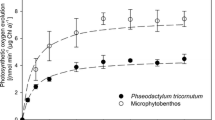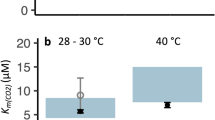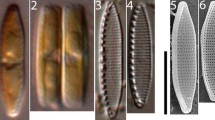Abstract
There have been no studies to date on the mechanisms of inorganic carbon acquisition by Antarctic microalgae. Consequently, we have examined inorganic carbon (DIC) use inNitzschia frigida, a diatom typical of the Antarctic bottom-ice community. The K0.5(CO2) of photosynthesis in this organism was estimated to be 1.09 µM at pH 7.5. The internal concentration of DIC was approximately 4050 µM at an external [DIC] of 45 µM. At air-equilibration levels of inorganic carbon this would be sufficient for a ten-fold accumulation ratio of CO2. Cells ofN. frigida are capable of carbon-dependent photosynthesis at rates that exceed that expected from uncatalysed CO2 supply to the cell. About 25% of the total carbonic anhydrase activity appears to be associated with the cell surface inN. frigida. These results support the hypothesis thatN. frigida, like many microalgae from temperate waters, has an active carbon-concentrating mechanism, associated with the ability to utilize external HCO −3 for photosynthesis.
Similar content being viewed by others

References
Badger MR, Andrews TJ (1982) Photosynthesis and inorganic carbon usage by the cyanobacteriumSynechococcus sp. Plant Physiol 70:517–523
Badger MR, Kaplan A, Berry JA (1977) The internal CO2 pool ofChlamydomonas reinhardtii — response to external CO2. Carnegie Inst Washington Yearb 76:362–366
Badger MR, Kaplan A, Berry JA (1980) Internal inorganic carbon pool ofChlamydomonas reinhardtii. Evidence for a carbon concentrating mechanism. Plant Physiol 66:407–413
Beardall J (1985) Occurrence and importance of HCO −3 utilization in microscopic algae. In: Lucas WJ, Berry JA (eds) Inorganic carbon uptake by aquatic photosynthetic organisms. American Society of Plant Physiologists, Rockville, Md, pp 83–96
Beardall J (1989) Photosynthesis and photorespiration in marine phytoplankton. Aquat Bot 34:105–130
Beardall J, Raven JA (1990) Pathways and mechanisms of respiration in microalgae. Mar Microb Foodwebs 4:7–30
Berry A, Boynton J, Kaplan A, Badger MR (1976) Growth and photosynthesis ofChlamydomonas reinhardtii as a function of CO2 concentration. Carnegie Inst Washington Yearb 75:423–432
Booth WA, Beardall J (1991) Effects of salinity on inorganic carbon utilization and carbonic anhydrase activity in the halotolerant algaDunaliella salina (Chlorophyceae). Phycologia 30:220–225
Boron WF, Roos A (1976) Comparison of microelectrode, DMO, and methylamine methods for measuring intracellular pH. Am J Physiol 3:799–808
Brown LW, Hellebust JA (1980) The contribution of inorganic solutes to osmotic balance in some green and eustigmatophyte algae. J Phycol 16:265–270
Burns BD, Beardall J (1987) Utilization of inorganic carbon by microalgae. J Exp Mar Biol Ecol 107:1–21
Davison I (1987) Adaptation of photosynthesis inLaminaria saccharina (Phaeophyta) to changes in growth temperature. J Phycol 23:273–283
De Michelis MI, Raven JA, Jayasuriya HD (1979) Measurement of cytoplasmic pH by the DMO technique inHydrodictyon africanum. J Exp Bot 30:681–695
Descolas-Gros C, DeBilly G (1987) Temperature adaptation of RUBP carboxylase:kinetic properties in marine Antarctic diatoms. J Exp Mar Biol Ecol 108:147–158
Garrison DL, Sullivan CW, Ackley SF (1986) Sea ice microbial communities in Antarctica. BioScience 36:243–250
Grossi S, McGrath ST, Kottmeier ST, Moe RL, Taylor GT, Sullivan CW (1987) Sea ice microbial communities VI. Growth and primary production under graded snow cover. Mar Ecol Prog Ser 35:153–164
Guillard RRL, Ryther JH (1962) Studies of the marine planktonic diatoms. I.Cyclotella nana Hustedt andDetonula confervaceae (Cleve) Gran. Can J Microbiol 8:229–239
Heldt HW, Werdan K, Milovancev M, Geller G (1973) Alkalization of the chloroplast stroma caused by light dependent proton flux into the thylakoid space. Biochim Biophys Acta 314:224–241
Jeffrey SW, Humphrey GW (1975) New spectrophotometric equations for determining chlorophyllsa, b, c 1 andc 2 in higher plants, algae and phytoplankton. Biochem Physiol Pflanz 167:191–194
Johnson KS (1982) Carbon dioxide hydration and dehydration kinetics in seawater. Limnol Oceanogr 27:849–855
Kaplan A, Badger MR, Berry JA (1980) Photosynthesis and the intracellular inorganic carbon pool in the blue green algaAnabaena variabilis: response to external CO2 concentration. Planta 149:219–226
Katz A, Avron M (1985) Determination of intracellular osmotic volume and sodium concentration inDunaliella. Plant Physiol 78:817–820
Kerby NW, Raven JA (1985) Transport and fixation of inorganic carbon by marine algae. Adv Biol Res 11:71–123
Kimpel DL, Togasaki RK, Miyachi S (1983) Carbonic anhydrase inChlamydomonas reinhardtii. I. Localization. Plant Cell Physiol 24:255–259
McLachlan JJA (1973) Growth media — marine. In: Stein JR (ed) Handbook of phycological methods. Culture methods and growth measurements. Cambridge University Press, Cambridge pp 25–51
Miller AG (1985) Study of inorganic carbon transport: the kinetic reaction approach. In: Lucas WJ, Berry JA (eds) Inorganic carbon uptake by aquatic photosynthetic organisms. American Society of Plant Physiologists, Rockville, Md, pp 17–30
Miyachi S, Tsuzuki M, Avramova ST (1983) Utilization modes of inorganic carbon for photosynthesis in various species ofChlorella. Plant Cell Physiol 24:441–451
Munoz J, Merrett MJ (1989) Inorganic carbon transport in some marine eucaryotic microalgae. Planta 178:450–455
Parker BC, Simmons GM, Wharton RA, Seaburg KG, Love FG (1982) Removal of organic and inorganic matter from Antarctic lakes by aerial escape of bluegreen algal mats. J Phycol 18:72–82
Paul JS (1979) Osmoregulation in the marine diatomCylindrotheca fusiformis. J Phycol 15:177–183
Rau GH, Takahashi T, DesMarais DJ (1989) Latitudinal variations in plankton δ13C: implications for CO2 and productivity in past oceans. Nature (London) 341:516–518
Raven JA (1976) Transport in algal cells. In: Luttge U, Pittman MG (eds) Transport in plants. II. (Encyclopedia of Plant Physiology, New Series, vol 2) Springer, Berlin Heidelberg New York, pp 129–188
Raven JA (1984) Energetics and transport in plants. Alan R Liss, New York
Raven JA (1985) The CO2 concentrating mechanism. In: Lucas WJ, Berry JA (eds) Inorganic carbon uptake by aquatic photosynthetic organisms. American Society of Plant Physiologists, Rockville, Md, pp 67–82
Raven JA (1990) Use of isotopes in estimating respiration and phototorespiration in microalgae. Mar Microb Foodwebs 4:59–86
Raven JA (1991) Implications of inorganic carbon utilization: ecology, evolution and geochemistry. Can J Bot 69:908–924
Riebesell U, Wolf-Gladrow DA, Smetacek V (1993) Carbon dioxide limitation of marine phytoplankton growth rates. Nature 361:249–251
Shiraiwa Y, Miyachi S (1983) Factors controlling induction of carbonic anhydrase and efficiency of photosynthesis inChlorella vulgaris 11 h cells. Plant Cell Physiol 26:919–923
Skirrow GA (1975) The dissolved gases — carbon dioxide. In Riley JP, Skirrow GA (eds) Chemical oceanography, vol 2. Academic Press, London, pp 1–192
Takahashi T (1989) The carbon dioxide puzzle. Oceanus 32:22–29
Werden K, Heldt HW, Geller G (1972) Accumulation of bicarbonate in intact chloroplasts following a pH gradient. Biochim Biophys Acta 283:430–441
Wilbur KM, Anderson NG (1948) Electrometric and colorimetric determination of carbonic anhydrase. J Biol Chem 176:147–154
Author information
Authors and Affiliations
Rights and permissions
About this article
Cite this article
Mitchell, C., Beardall, J. Inorganic carbon uptake by an Antarctic sea-ice diatom,Nitzschia frigida . Polar Biol 16, 95–99 (1996). https://doi.org/10.1007/BF02390429
Received:
Accepted:
Issue Date:
DOI: https://doi.org/10.1007/BF02390429



